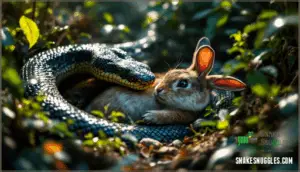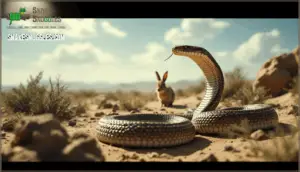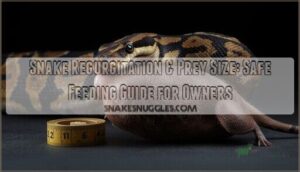This site is supported by our readers. We may earn a commission, at no cost to you, if you purchase through links.

From Burmese pythons swallowing marsh rabbits whole in the Florida Everglades to boa constrictors targeting domestic rabbits in backyard enclosures, the evidence is both documented and alarming.
Understanding which snake species pose the greatest risk, how they hunt, and what makes rabbits vulnerable can mean the difference between a safe pet and a devastating loss.
Table Of Contents
Key Takeaways
- Large constrictor snakes—including Burmese pythons, boa constrictors, and African rock pythons—can and do eat rabbits when the snake’s body size matches or exceeds the rabbit’s weight, with documented cases showing pythons responsible for up to 77% of marsh rabbit deaths in Florida’s Everglades.
- Pet rabbits face real danger from snakes that can slip through surprisingly small gaps, making secure outdoor hutches with quarter-inch hardware cloth mesh, elevated designs at least 18 inches off the ground, and buried fencing critical for protection.
- A snake’s ability to consume a rabbit depends entirely on size ratios: dwarf rabbits (2-4 lbs) are vulnerable to medium constrictors, while giant breeds (15+ lbs) are safe from most species except the largest pythons exceeding 10 feet in length.
- Snake-rabbit predation follows opportunistic patterns driven by prey availability rather than preference, meaning habitat overlap and enclosure security matter more than the mere presence of snakes in an area.
Snake Size Vs Rabbit Size
Whether a snake can eat a rabbit really comes down to a simple numbers game—size matters. You need to know how big your rabbit is compared to the snakes in your area.
Let’s break down the typical sizes you’re working with so you can gauge the real risk.
Average Size of Pet Rabbits
Most pet rabbits fall somewhere between a small cat and a medium-sized house cat regarding weight, but understanding exactly how big your rabbit is helps you assess whether they’re at risk from local snakes.
Domestic rabbits come in various breed sizes, from tiny dwarf rabbits like Holland Lops at around 3-4 pounds to giant breeds exceeding 15 pounds. Your rabbit’s growth rate and weight range depend heavily on their genetics and diet.
| Breed Type | Average Weight | Length | Common Examples |
|---|---|---|---|
| Dwarf/Mini | 2-4 lbs | 8-10 inches | Netherland Dwarf, Holland Lop |
| Medium | 5-8 lbs | 12-16 inches | Dutch, Mini Rex |
| Large/Giant | 10-20+ lbs | 18-24 inches | Flemish Giant, French Lop |
Knowing your rabbit’s size helps you understand their vulnerability and housing needs when considering snake threats.
Average Size of Wild Rabbits
While pet rabbits live cushy indoor lives, their wild relatives face real danger every day—and understanding their size helps explain why they’re such tempting targets for hungry snakes. Wild rabbits like the Eastern Cottontail usually weigh 2-4 pounds and stretch 15-18 inches long—prime prey size for many snake species.
Regional size variation affects predator-prey dynamics greatly, with diet influence, seasonal size changes, and lifespan all playing roles in determining vulnerability.
| Rabbit Species | Average Weight & Length |
|---|---|
| Eastern Cottontail | 2-4 lbs, 15-18 inches |
| Marsh Rabbit | 2-3 lbs, 12-16 inches |
| Swamp Rabbit | 4-6 lbs, 18-22 inches |
| Desert Cottontail | 1.5-3 lbs, 12-15 inches |
Snake prey size compatibility means most wild rabbits fall within the ideal range for medium to large constrictors.
Comparison With Snake Species
When you put snake species side by side with rabbit sizes, the matchup reveals which predators pose the biggest threat to which bunnies. Snake size matters most—larger constrictors like Burmese pythons (10-20 feet) can easily overpower adult rabbits, while smaller brown snakes (2-3 feet) target newborns. Venomous vs. non-venomous doesn’t dictate snake diet as much as body size does.
Regional variations and habitat overlap determine which types of snakes that eat rabbits you’ll encounter.
| Snake Species | Rabbit Prey Size |
|---|---|
| Burmese Python | Adult rabbits (4-6 lbs) |
| Boa Constrictor | Juvenile to adult (2-5 lbs) |
| Bull Snake | Young rabbits (under 2 lbs) |
| African Rock Python | Large adults (5+ lbs) |
Snake Diet and Hunting Habits
Snakes aren’t picky eaters, but they do have patterns in what they hunt and how they eat. Understanding their diet and hunting style helps you see why rabbits end up on the menu.
Let’s look at what drives a snake’s feeding choices and the physical tricks that make them such effective predators.
Preferred Prey of Snakes
Snakes aren’t picky eaters, but they do have favorites that keep them coming back for more. Small rodents—especially mice and rats—top the menu because they’re easy to catch and perfectly sized for most snake species. Here’s what drives snake prey selection:
- Size matters: Snakes target prey they can swallow whole, usually no wider than their head.
- Availability wins: Abundant prey animals like rodents become dietary staples simply because they’re everywhere.
- Energy payoff: Hunting success depends on balancing effort with nutritional reward.
Rabbits fit these criteria for larger snakes, making them vulnerable when snake food sources overlap with their habitat.
Adaptable Hunters and Prey Variety
If mice vanished tomorrow, most snakes wouldn’t skip a meal—they’d just switch their focus to whatever else crosses their path. This dietary adaptation reflects millions of years of evolution as opportunistic feeders.
Their hunting strategies rely on prey selection based on availability rather than strict preferences. Snakes constantly assess their environment, adjusting their snake food sources from lizards to birds to young rabbits.
This flexibility explains why larger constrictors target rabbits when rodent populations dip. Whether using venom or constriction, they’re masters at making the most of whatever meal opportunity presents itself.
Unique Jaw Structure for Swallowing Prey
Most predators need powerful teeth to tear apart dinner, but snakes pull off something way more impressive—their jaws literally unhinge to gulp down prey that looks impossible to swallow. This jaw flexibility stems from skull adaptations where loosely connected bones allow their jaw gape to expand dramatically. The esophagus expansion and swallowing mechanism work together, allowing their bodies to stretch around rabbits several times wider than their head.
Snake jaw anatomy includes these fascinating features:
- Ligaments replace rigid joints, letting both lower jaw halves move independently
- Skull bones shift and separate during the digestion process to accommodate large prey
- Backward-facing teeth grip while muscular contractions inch food down their throat
- Their windpipe pushes forward like a snorkel so they can breathe mid-meal
Documented Cases of Snakes Eating Rabbits
While it’s understood snakes can eat rabbits, real-world evidence brings this predator-prey relationship into sharper focus.
Documented encounters—from scientific studies to backyard incidents—show exactly how and when snakes target rabbits. Let’s look at the recorded cases that prove this isn’t just theory.
Constrictors and Rabbits
When a python wraps around a rabbit, the outcome is as predictable as it’s swift. These constrictors use powerful muscles to squeeze, cutting off blood flow and oxygen in seconds. Boa constrictors and pythons possess impressive jaw flexibility, allowing them to swallow rabbits whole after constriction. The digestion process can take days, depending on the rabbit’s size.
Your outdoor rabbits face real python threat in areas where these constricting snakes live. Secure enclosures with tight-mesh fencing prevent these snake and rabbit interactions before they start.
Scientific Observation of Snake-Rabbit Interactions
Field researchers have documented snake-rabbit interactions through careful observational techniques across diverse ecosystems. Here’s what data collection reveals:
- Geographic Variations: Documented cases of snakes eating rabbits show pythons actively hunting marsh rabbits in Florida’s Everglades, where habitat overlap creates frequent snake-rabbit interactions.
- Predator-Prey Dynamics: Snake species known to eat rabbits exhibit opportunistic feeding, with effects of snake predation on rabbit populations reaching up to 99% reductions in some areas. The python’s impact on the rabbit population is significant.
- Ethical Considerations: Future research on snake-rabbit dynamics in food chains balances environmental impact studies with non-invasive monitoring methods.
Attacks on Pet Rabbits
Pet rabbits living outdoors face a real threat from hungry snakes that view backyard hutches as convenient feeding stations. Predator identification helps you recognize which local snake species pose risks to your pet rabbits.
Enclosure breaches happen through surprisingly small gaps—snakes slip through wire spacing or damaged sections of your rabbit hutch. Owner vigilance means checking for signs of snakes daily and inspecting snakeproof fencing regularly.
Post-attack care requires immediate veterinary attention if your rabbit survives an encounter. Protecting rabbits from snakes demands constant attention to rabbit safety and secure housing.
Protecting Pet Rabbits From Snakes
If you have a pet rabbit, you’re right to wonder whether snakes pose a real threat. The good news is that a few practical steps can dramatically reduce the risk.
Here’s how to keep your rabbit safe from unwanted serpent visitors.
Secure Outdoor Hutches and Enclosures
If you think your backyard rabbit hutch is safe just because it looks sturdy, you might be underestimating what a determined snake can do. Snakes can slip through surprisingly small openings in your rabbit enclosure. To create a truly snakeproof enclosure, focus on these essentials:
- Hutch Material Safety: Use hardware cloth with quarter-inch mesh instead of chicken wire—snakes can’t squeeze through smaller gaps.
- Elevated Hutch Designs: Raise your outdoor hutch at least 18 inches off the ground to discourage burrowing attempts.
- Predator-Proofing Techniques: Install snakeproof fencing buried 6-8 inches underground around the rabbit hutch perimeter.
Supervising Outdoor Time and Monitoring Environment
Even a secure hutch won’t help much if you’re not actually watching your rabbit when they’re hopping around outside. Active supervision means you’re present—not just glancing through a window.
Snakes often hunt during dawn and dusk, so predator awareness matters most during these hours. Check your yard for snake hiding spots like tall grass or debris piles before letting your rabbit explore. Seasonal changes affect snake activity too—they’re more active in warm months when rabbit attacks peak.
Snake-Proof Fencing and Prevention
You don’t need a moat, but the right fencing can stop most snakes before they even think about your rabbit. Install hardware cloth with a mesh size of ¼-inch or smaller—snakes can’t squeeze through tight gaps. Your barrier height should reach at least three feet above ground, with ground barriers buried 12 inches deep to block burrowing.
Consider natural repellents like cinnamon oil around the perimeter.
These safety precautions work for both baby rabbit protection and adult rabbit safety, creating solid prevention through smart fencing materials choices.
Snake Species That Eat Rabbits
Not all snakes pose a threat to your rabbits, but certain species have the size and hunting skills to target them. The snakes you need to watch for depend on where you live and how large your rabbit is.
Let’s look at which species are most likely to see your bunny as their next meal.
Types of Snakes That Prey on Rabbits
Large constrictors dominate rabbit predation across different regions. Burmese pythons are responsible for 77% of marsh rabbit deaths in southern Florida parks, dramatically reshaping local ecosystems.
In southern Florida parks, Burmese pythons kill 77% of marsh rabbits, dramatically reshaping local ecosystems
Native predators like Florida pine snakes, eastern diamondback rattlesnakes, and black rat snakes also hunt rabbits, though their impact is far less severe. Regional variations matter—invasive pythons threaten Florida’s marsh rabbits, while native constrictors target eastern cottontails throughout rural America. The threatened Florida pine snake is one such native constrictor.
Juvenile vulnerability remains high everywhere, as smaller rat snakes easily raid rabbit nests for newborns.
Characteristics of Each Snake Species
Understanding which snakes pose a real threat to your rabbits means knowing what separates a harmless garden snake from a genuine predator. The key differences come down to a few critical traits that determine whether your bunny is at risk.
Snake species that eat rabbits share these defining characteristics:
- Size matters most: Snakes over two feet can tackle young rabbits, while six-footers subdue adults with ease. A four-foot rat snake won’t bother full-grown bunnies but will raid nests without hesitation.
- Constriction power: Pythons, boa constrictors, and rat snakes use muscular coils to suffocate prey before swallowing. This hunting method works perfectly on warm-blooded, struggling rabbits.
- Habitat range overlap: You’ll find rabbit predators in woodlands, grasslands, and wetlands where prey populations thrive. Florida’s Everglades host Burmese pythons, while eastern diamondback rattlesnakes prowl southeastern forests.
- Venom potency vs. size: Venomous species like rattlesnakes can take rabbits, but non-venomous constrictors dominate simply through overwhelming size advantage.
Temperament traits vary—some snakes actively hunt while others ambush opportunistically.
Size Considerations for Each Species
A snake’s hunting success hinges on whether it can physically overpower and swallow a rabbit, which depends entirely on how its body size stacks up against the prey. The average size of pet rabbits ranges from 2 to 20 pounds, while wild rabbits usually weigh 2 to 4 pounds—making prey size a critical factor.
Garter snakes (18-26 inches) can’t tackle adult rabbits but might manage newborns. Rat snakes (3-6 feet) and kingsnakes (3-4 feet) can eat juvenile rabbits once they exceed two feet. Corn snakes (3-5 feet) stick to smaller prey due to their slender build. Regional snake sizes vary—Florida’s Burmese pythons (12-18 feet) easily consume full-grown rabbits, demonstrating how exotic snake growth dramatically expands prey size limits. Juvenile snake diets shift as they mature, gradually allowing larger targets.
Feeding Habits of Snake Species
Each snake species has its own playbook for hunting and eating. Some are ambush experts, while others actively track their meals across different terrains.
Let’s look at how the rabbit-eating snakes we’ve covered actually catch and consume their prey.
Hunting and Feeding Strategies of Each Species
Different snake species hunt like specialist chefs with their own signature techniques—some ambush their meals with lightning speed, while others slowly suffocate prey in a crushing embrace. Garter snakes use opportunistic ambush tactics, striking whatever crosses their path.
Kingsnakes, rat snakes, corn snakes, and milk snakes rely on constriction methods—wrapping coils around prey until suffocation occurs. While these constrictors can target newborn rabbits, they usually choose easier meals like mice or rats, using heat-sensing abilities for prey detection in the wild.
Prey Preferences and Dietary Variations
Snakes exhibit striking flexibility in their feeding strategies, with prey preferences and dietary variations influenced by size. Studies tracking 1,583 snake species reveal that dietary adaptations shift dramatically with size—smaller snakes generally consume ectotherms, while larger constrictors prefer mammals like rabbits.
This size influence on prey selection means pythons and boa constrictors can target adult rabbits, especially as they grow. Snake species that eat rabbits typically exceed two feet in length. Notably, invasive Burmese pythons consume two-thirds of rabbit mortalities in high-density zones, highlighting their significant impact.
These dietary adaptations reflect how prey consumed by snakes varies by season, location, and availability. As a result, rabbit species are particularly vulnerable in areas where large constrictors thrive.
Unique Feeding Habits of Each Species
Each snake species brings its own signature move to the dinner table, from the lightning-fast strikes of venomous hunters to the slow, methodical squeeze of powerful constrictors. Pythons and boa constrictors excel at consuming rabbits through constriction, suffocating prey before swallowing it whole. Their digestion rates are remarkably slow—sometimes taking weeks to process a rabbit-sized meal.
Rat snakes and kingsnakes rely on quick strikes and suffocation tactics, adapting their hunting styles based on prey size availability. Meanwhile, garter snakes function as opportunistic feeders, targeting smaller mammals when rabbits aren’t accessible.
Safety Precautions and Prevention
If you spot a snake near your rabbit’s space, staying calm and acting quickly makes all the difference. You have a few options to keep your rabbits safe, from simple deterrents to bringing in expert help.
Let’s look at practical ways to approach these situations and prevent future encounters.
Dealing With Snakes Approaching Rabbits
Spotting a snake closing in on your rabbit can feel like watching a predator circle its prey—time slows down, and your instinct to protect kicks in fast. Here’s how to respond when snake behavior and hunting threatens rabbit safety and protection:
- Stay calm and assess the threat—identifying the snake species helps you gauge risk and choose appropriate snake deterrents.
- Create distance immediately—gently move your rabbit to safety without startling the snake.
- Strengthen enclosure security—check for gaps where snakes entered and seal them with hardware cloth.
- Modify the habitat—remove brush piles and tall grass that attract snakes near rabbit areas.
Early detection and habitat modification are your best defenses against future encounters.
Scare Tactics and Professional Removal
Sometimes the best defense is simply convincing a snake it’s picked the wrong neighborhood. DIY deterrents like loud noises, vibrations, or a spray from your hose can encourage snakes to move along without harm.
Snake repellents and ultrasonic devices show mixed results, but they’re worth trying for prevention.
If snake attacks feel imminent or you’re dealing with persistent visitors, professional services offer humane removal with proper training and equipment. Wildlife experts relocate snakes safely, protecting both your rabbit’s safety and the snake’s habitat needs elsewhere.
Creating a Snake-Friendly Habitat Away From Rabbits
Instead of just scaring snakes off, you can actually guide them toward a better spot where they won’t threaten your rabbits. Set up a snake habitat away from your bunny protection zone using natural barriers like rock piles and native plants for shelter options.
Add water sources and habitat enrichment that attracts alternative prey like mice. This humane snake removal strategy encourages prevention by giving snakes what they need elsewhere, balancing snake safety with your rabbit’s security.
Frequently Asked Questions (FAQs)
Do snakes eat rabbits?
Yes, snakes eat rabbits—and this predation plays an important role in ecosystem balance. Snake diet includes rabbits when habitat overlap occurs, making rabbit vulnerability a real concern.
Types of snakes that eat rabbits range from constrictors to opportunistic hunters adapting to available prey.
Can a baby snake eat a rabbit?
Baby snakes can’t eat adult rabbits, but they may prey on baby rabbits or juvenile rabbits. Snake prey size depends on baby snake size, snake jaw size, and digestion challenges.
Rabbit kit size and vulnerability factors determine if snake predation occurs, as newborn kits are especially susceptible.
Why do snakes eat rabbits & pythons?
Snakes aren’t picky eaters—they’re just trying to survive. Rabbits offer high protein and fat to meet nutritional needs, and they’re often abundant prey.
Pythons, especially invasive species, exploit prey availability to thrive, disrupting ecosystem balance through their predatory nature and evolutionary drivers.
Do constrictor snakes eat rabbits?
Boa constrictors and pythons absolutely prey on rabbits. These constrictors use powerful coiling mechanics to suffocate their prey before swallowing them whole.
Larger species easily overpower adult rabbits, while smaller constrictors target young bunnies.
Are rabbits safe from snakes?
Your rabbit’s safety depends on its size and where it lives. Adult rabbits face low predation risk from most snake species—predators under six feet can’t usually overpower full-grown prey. But baby rabbits and smaller rabbit breeds remain vulnerable.
Outdoor enclosures with weak habitat risks allow snake threat level to rise, so enclosure security matters for weaning them.
Can snakes kill rabbits?
Large constrictors and some venomous species can definitely kill rabbits through constriction methods or venom effects. Snake predation poses real vulnerability for rabbits, especially younger ones, since the size disparity between predators and prey determines hunting success.
Do snakes go after rabbits?
When a snake catches the scent of vulnerability, your rabbit becomes a target. Snakes actively hunt rabbits when hungry, especially smaller or young ones.
They’re drawn to easy prey in unsecured enclosures, making snake predation a real risk where predators and prey overlap naturally.
Can rabbits fight snakes?
Rabbits don’t usually fight back against snakes. Their survival odds depend on protective behaviors like kicking or fleeing, but these prey animals rarely show rabbit aggression toward predators.
Snake vulnerability exists only if the rabbit escapes quickly—fighting back usually isn’t part of their defense strategy.
Do snakes keep rabbits away?
It’s not quite that simple. While snakes are predators and rabbits are prey, the predatory nature of snakes doesn’t usually keep rabbits away. Snakes hunt opportunistically, so they don’t actively patrol areas or deter rabbits through their presence alone.
However, snake predation does help maintain ecosystem balance by naturally controlling rabbit populations over time.
Do king snakes eat baby rabbits?
King snakes—opportunistic constrictors with surprisingly flexible jaws—will absolutely hunt baby bunnies when the chance arises. These predators target vulnerable newborns in their natural habitats, using constriction to overpower small prey.
If you’re raising rabbits outdoors, secure enclosures with hardware cloth prevent kingsnakes from accessing baby rabbits.
Conclusion
An ounce of prevention is worth a pound of cure when safeguarding your rabbits from snakes. Understanding that do snakes eat rabbits isn’t just trivia—it’s critical knowledge that enables you to protect your pets.
Secure enclosures, vigilant monitoring, and habitat modifications create barriers between predator and prey. The bond you share with your rabbit deserves this level of care, transforming awareness into action that safeguards the vulnerable creatures under your watch.
- https://royalsocietypublishing.org/doi/10.1098/rspb.2015.0120
- https://reptilesdoc.com/do-snakes-eat-rabbits/
- https://www.reddit.com/r/snakes/comments/1p0t10/feeding_a_live_rabbit_to_a_still_young/
- https://pmc.ncbi.nlm.nih.gov/articles/PMC8516226/
- https://petwave.com.au/blogs/our-blog-2/whats-the-right-size-food-for-my-snake















